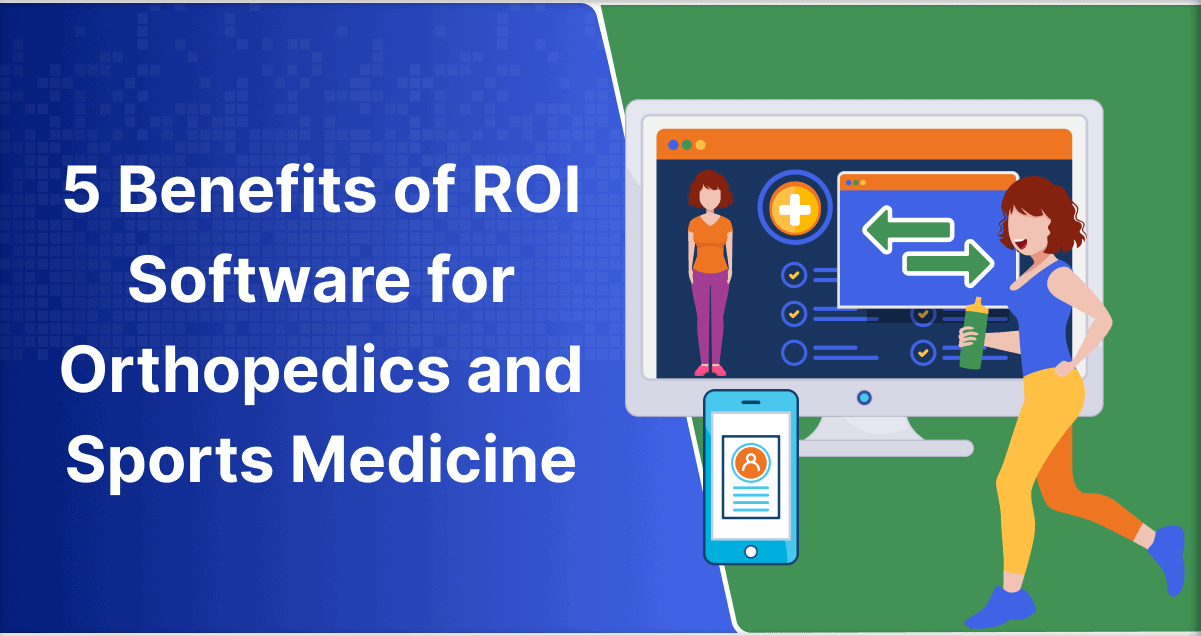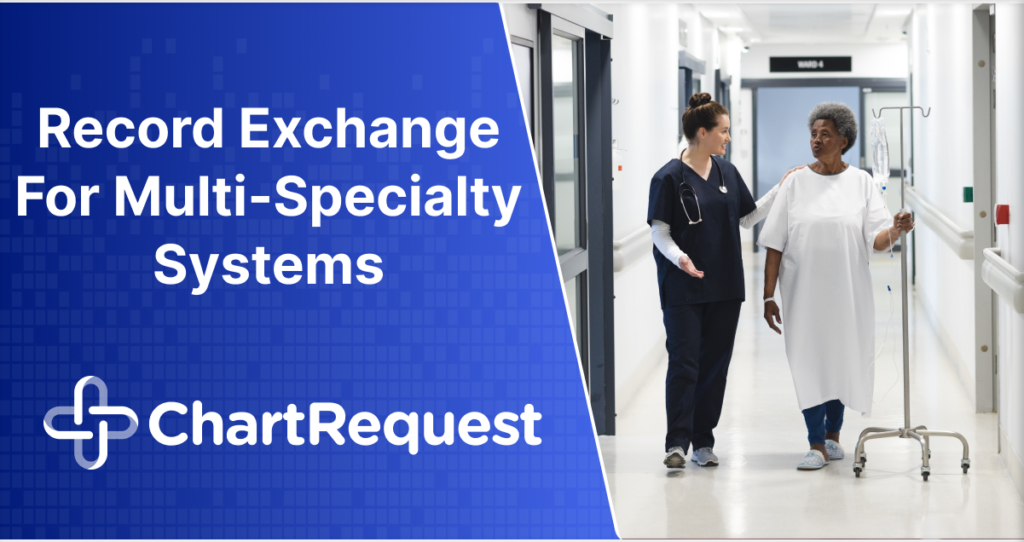Managing medical records and images is crucial in orthopedics and sports medicine, but this mandatory responsibility is often bogged down by old-school, manual methods.
Usually, this means dealing with a lot of paper files and physical CDs, which are a hassle to manage and share.
This old-fashioned way can slow things down in a busy medical practice, and it raises concerns about keeping Protected Health Information (PHI) safe and private.
Digitizing the sharing of medical records can make a big difference for orthopedics and sports medicine specialists. Going digital means records and images are easier to get to, convenient to store, and simpler to work with.
Release of Information (ROI) solutions like ChartRequest shines in this area. It’s because modern ROI solutions are designed to make sharing medical records and images quick, secure, and compliant with HIPAA regulations.
This article will examine the top 5 ways going digital can help orthopedics and sports medicine doctors. These changes can lead to a more efficient, secure, and focused practice on the patient.
History of Traditional Release of Information
Traditional ROI was a manual process. It’s a heavily paper-based approach with strict legal guidelines. Thus, managing medical records and images in orthopedics and sports medicine was a slow and tedious task.
Let’s break down the traditional ROI process:
- Manual retrieval of records: Initially, healthcare staff had to physically locate and pull out the required patient records from vast paper archives.
- Duplicating records: Once found, these records need to be duplicated manually. This meant photocopying or printing the necessary documents and images.
- Ensuring legal compliance: A crucial part of the process was ensuring everything complied with healthcare laws, especially HIPAA. To protect patient privacy, healthcare professionals need to thoroughly check authorization forms and retrieved records.
- Physically distributing records: Finally, the records had to be manually sent to the requestor usually via mail or fax.
The drawbacks of this process were highlighted in a 2021 survey. 81% of people said that different healthcare providers should be able to efficiently share health data about the same patients. This finding reflects a strong preference for a more streamlined, quicker method of information sharing.
While the traditional ROI process was detail-oriented, the sheer volume and opportunity for human error aren’t suited for the fast, interconnected nature of modern healthcare.
Current Challenges in Manually Handling of Medical Images
More than 250,000 people in the US die every year from preventable diseases because of errors in diagnosis, and inefficient health IT systems hold some of the blame.
Managing medical images the old-fashioned way – manually – comes with a host of problems. ROI is crucial for patient care but can be slow and full of pitfalls with the traditional process.
Let’s look at the main issues with this approach:
1. Delays and inefficiency: Manual handling of medical images often leads to delays. Searching for and sharing these images can take up much time, potentially delaying important diagnoses and treatments. This isn’t just inconvenient; it can seriously affect patient health.
2. Storage problems: Keeping physical films and CDs takes up a lot of space, which can amount to huge cost spikes in areas like New York City. Organizing and managing these can be quite a task, especially in busy medical practices where space and time are at a premium.
3. Security risks: Physical films and CDs, which carry sensitive patient data, can easily be lost, stolen, or damaged. This raises the risk of data breaches. AHIMA also highlights that the manual ROI process can lead to data breaches and errors in managing patient records.
4. Challenges in collaborative care: It’s hard for multiple doctors to access and review a case together when medical images are stuck on physical media. This can be a barrier to coordinating care, which is often necessary in orthopedics and sports medicine.
5. Environmental concerns: The production and disposal of films and CDs contribute to environmental waste, which is an increasing concern in the healthcare industry.
These challenges put a spotlight on the need for a more efficient, secure, and eco-friendly way to manage medical images.
How Digitizing ROI Can Boost Orthopedics and Sports Medicine
Digitizing ROI for healthcare images is making a huge difference for orthopedics and sports medicine doctors. Simply put, this means turning all those paper files and physical images into digital versions.
It’s a big deal for these specialties because they often need detailed images to make sure they diagnose and treat patients correctly.
Healthcare professionals spend an average of 10 hours weekly on paperwork and administrative tasks, and this average is even higher in orthopedics and sports medicine. This is a direct consequence of the data silos that come with varying EMR systems in each practice.
ChartRequest is a modern software that helps bridge the gap caused by paper records and incompatible EMR systems.
Our release of information software tackles the problems that come with old-school methods of receiving and releasing medical, imaging, and billing records. These old methods can slow down patient care and force doctors to spend too much time on paperwork.
Digitizing ROI streamlines these processes. This helps in freeing up valuable time for patient care and other critical tasks. Plus, there’s less paperwork to deal with, which makes it easier to protect patient information and keep up with HIPAA-regulated turnaround times.
Moving to digital ways of sharing medical images will help orthopedics and sports medicine specialists provide better, safer, and more focused care for their patients.
5 Key Benefits of Electronic ROI for Orthopedics and Sports Medicine
Getting the right information quickly and accurately is crucial. The same is also true for orthopedics and sports medicine specialists when it comes to images.
This is where digital ROI solutions make a big difference.
It’s not just about new technology — it’s about completely changing the way medical records are shared.
The healthcare sector is dealing with an overwhelming amount of data, nearly 30% of the world’s total. And it’s growing fast, with expectations to increase by 36% each year until 2025.
This massive data needs to be managed well, and that’s where digitization comes in.
below are the benefits of electronic ROI:
1. Improved Access to Patient Information
Having quick access to patient information is critical in orthopedics and sports medicine. Electronic ROI helps medical images be easily accessible with just a click. This instant access is especially important when dealing with urgent situations like sports injuries.
Quick access to patient information allows these specialists to make fast and informed decisions that are elements of effective treatment.
A report from Merritt Hawkins highlights this need for speed. According to the report, the average wait time to see an orthopedic surgeon is now 16.9 days, a significant increase from 2017.
When the wait to even see a doctor is so long, patients don’t want delays in records access to delay their care plans.
2. Robust Data Security and Compliance with HIPAA
Tight security is crucial because mishandling patient data can have serious consequences.
In 2014, Parkview Health System had to pay $800,000 because of a breach caused by the improper disposal of paper records. This incident shows the dangers of not protecting patient data properly.
ChartRequest has safeguards in place to protect patient information that meet all relevant HIPAA rules and keep patient details private.
We also use powerful security features like unbreakable encryption and access controls to help healthcare professionals manage orthopedics and sports medicine records.
3. Operational Efficiency and Time Savings
Electronic ROI helps speed up the process of getting and sharing medical records, saving time and cutting down on busy work. This is really important because many doctors are feeling overwhelmed.
In fact, about 40% of all doctors in primary care in the U.S. experience burnout, and the burnout rate of orthopedic surgeons is about 55% higher than this.
By using ROI solutions like ChartRequest, doctors can work more efficiently and reduce the administrative stress that comes with the job.
4. Improved Patient Care and Outcomes
Going digital with medical records retrieval helps orthopedics and sports medicine doctors provide informed care quickly. It also enables them to quickly get and share key info like referrals, test results, and patient medication details.
Being capable of quickly sharing PHI is essential. A 2015 study showed 67.9% of doctors sent referrals electronically, while many received lab results (78.8%), imaging reports (60.8%), and medication lists (54.4%) this way.
These numbers highlight the importance of adopting an electronic method of receiving and releasing medical, imaging, and billing records to keep up with the industry.
5. Cost-Effective and Eco-Friendly Approach
Electronic ROI and image management in orthopedics and sports medicine offer both financial and environmental benefits. Switching from physical CDs to digital formats can help cut costs.
For example, the traditional way of producing a CD for a patient can cost between $10 and $25. When you include shipping costs, the cost increases further.
However, by adopting digital methods, healthcare providers can save substantial amounts of money. A great example of this is Yale New Haven Health System, which saved over $650,000 in 2020 and was on track to save over $1 million in 2021 after switching to electronic image exchange.
Besides being cost-effective, going digital is also eco-friendly. It reduces the need for producing and discarding CDs, lowering healthcare practices’ environmental footprint.
Case Study: NY Orthopedics Switched to Save $136K+ / Year in ROI Staffing
NY Orthopedics, a leader in orthopedic and sports medicine research, switched to using ChartRequest for handling their medical records and saw some great benefits.
Before ChartRequest, they were spending a lot of money and facing problems with their old ROI method. But after they started using ChartRequest, they saved over $136,000 every year just on projected additional staffing costs.
ChartRequest helps them manage medical, imaging, and billing records online. This change made things more efficient and saved them space. They didn’t need to hire more people or spend time training them because ChartRequest’s system was easy to use and did a lot of the work for them.
On top of saving money, working with ChartRequest made things faster and simplified compliance with release of information regulations. Overall, NY Orthopedics’ experience shows how helpful ChartRequest can be for healthcare places, saving them money and making their work smoother.
Enhance Healthcare Delivery with ChartRequest
Release of information solutions like ChartRequest are changing the field of medical image sharing for orthopedics and sports medicine specialists.
By transitioning to digital image exchange, you’ll unlock efficiency and accuracy that manual processes simply can’t match.
ChartRequest leads the way in this digital revolution, offering rapid access to critical patient information, enhanced data security in compliance with HIPAA, and significant operational efficiency. This shift also streamlines your workflow and positively impacts patient care and outcomes.
Want to learn more about ChartRequest and elevate your practice to new heights of efficiency? Book a demo to learn how we can help transform the way you deliver healthcare information today!









